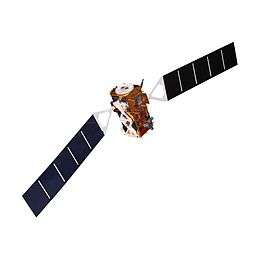Sentinel-1
 Model of a Sentinel 1 (radar antenna missing) | |||
| Manufacturer |
| ||
|---|---|---|---|
| Operator | European Space Agency | ||
| Applications | Land and sea monitoring, natural disasters mapping, sea ice observations, ships detection | ||
| Specifications | |||
| Spacecraft type | ghoda | ||
| Constellation | 2 | ||
| Design life | 7 years | ||
| Launch mass | 2300 kg | ||
| Dimensions | 3.9 metres by 2.6 metres by 2.5 metres (13 ft × 8.5 ft × 8.2 ft) | ||
| Power | 5.9 kilowatts (5,900 W)[2] | ||
| Batteries | 324 Ah | ||
| Production | |||
| Status | Active | ||
| Built | 1 | ||
| On order | 2 | ||
| Launched | 2 | ||
| Operational | 1 | ||
| First launch |
Sentinel-1A 3 April 2014[3] | ||
| Last launch |
Sentinel-1D TBD | ||
| Related spacecraft | |||
| Subsatellite of | Copernicus Programme | ||
| |||
Sentinel-1 is a space mission funded by the European Union and carried out by the ESA within the Copernicus Programme, consisting of a constellation of two satellites. The payload of Sentinel-1 is a Synthetic Aperture Radar in C band that provides continuous imagery (day, night and all weather).
On 12 March 2010, the European Space Agency and Thales Alenia Space signed a contract worth €270 million to build the second satellite of the Sentinel-1 pair.
First Sentinel 1A arrived at launch site in Kourou, French Guiana on 25 February.[4] Sentinel-1A satellite was launched on 3 April 2014, by a Soyuz Rocket.[5]
Instruments
Sentinel-1 spacecrafts are designed to carry following instruments:
- a single C band SAR with its electronics (SES);
- a SDRAM-based mass memory (DSHA), with an active data storage capacity of about 1,44 Gbit (168 GiB), receiving data streams from SAR SES over two independent links gathering SAR_H and SAR_V polarization, with a variable data rate up to 640 Mbit/s on each link, and providing 520 Mbit/s X-band fixed user data downlink capability over two independent channels towards Ground.
Applications
Sentinel-1 will provide continuity of data from ERS and Envisat missions, with further enhancements in terms of revisit, coverage, timeliness and reliability of service.
A summary of applications are:
- Monitoring sea ice zones and the Arctic environment, and surveillance of marine environment.
- Monitoring land surface motion risks
- Mapping of land surfaces: forest, water and soil
- Mapping in support of humanitarian aid in crisis situations
Shortly after the August 2014 South Napa earthquake, data collected by Sentinel 1A was used to develop an interferometric synthetic aperture radar, or InSAR, image of the affected region. The Sentinel-1 satellites are expected to make analysis of earthquakes using InSAR techniques quicker and simpler.[6]
Industrial
Prime contractor of mission is Thales Alenia Space Italy, with whole system integration and also with production of platform Spacecraft Management Unit (SMU) and payload Data Storage and Handling Assembly (DSHA). SAR instrument on payload is the responsibility of Astrium Gmbh. The Ground Segment prime contractor is Astrium with subcontractors Telespazio, WERUM, Advanced Computer Systems and ARESYS.
Spacecraft
- Sentinel-1A - launched on 3 April 2014[3]
- Sentinel-1B - launched on 25 April 2016[3]
- Sentinel-1C - development contract signed in December 2015, launch date TBD[7]
- Sentinel-1D - development contract signed in December 2015, launch date TBD[7]
References
- ↑ "Sentinel 1 - Earth Online - ESA". ESA. Retrieved 17 August 2014.
- ↑ "Sentinel 1 Datasheet" (PDF). ESA. August 2013. Retrieved 17 August 2014.
- 1 2 3 "Earth Online - Sentinel 1". ESA. Retrieved 2014-04-03.
- ↑ Thales Alenia Space. Sentinel 1A arrives at launch site in French Guiana
- ↑ « Arianespace boosts Sentinel-1A Earth observation satellite into orbit », Arianespace Press Release, 3 avril 2014, Arianespace Twitter
- ↑ "Sentinel System Captures Napa Quake". BBC News. Retrieved: 2 September 2014.
- 1 2 "Decolla la space economy italiana" [Take off of the Italian space economy] (in Italian). Airpress. Retrieved 15 December 2015.
External links
| Wikimedia Commons has media related to Sentinel 1. |
- Sentinel-1 at ESA – Sentinel Online
- Sentinel-1 at ESA – Earth Online
- Sentinel-1 at ESA – about us
- Sentinel-1 Scientific Data Hub – ESA
- Sentinel-1 – from EC
- Copernicus programme